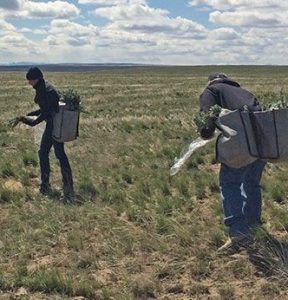Restoration
View brief.
In a 16-year study, Rocky Mountain Research Station Research Ecologist Sharon Hood and her colleagues assessed three types of radial thinning to determine whether they would improve the growth and survival of sugar pines, a species of white pine, in southwest Oregon on sites located in the Umpqua National Forest and Bureau of Land Management Roseburg District. In addition to evaluating a control group, the researchers examined three kinds of treatments in which trees and shrubs were removed around sugar pines to 3 m (10 ft); 7.6 m (25 ft), while retaining large trees with diameters greater than 64 cm (2 ft); or 7.6 m (25 ft). Though some of the radial thinning strategies seemed promising at the 9-year mark, the radial thinning did not improve sugar pine survival at the end of the study (year 16), as compared to the control group. The extended (7.6 m) radial thinning with complete tree removal treatment did increase tree growth for sugar pine that survived, but the level of tree mortality was similar regardless of whether trees had radial thinning or not. Most tree mortality was due to the native mountain pine beetle.
View article.
Field data from 460 sagebrush populations sampled across the Great Basin revealed several patterns. Sagebrush seedlings were uncommon in the first 1–2 years after fire, with none detected in 69% of plots, largely because most fires occurred in areas of low resistance to invasive species and resilience to disturbance (hereafter, R&R). Post-fire aerial seeding of sagebrush dramatically increased seedling occupancy, especially in low R&R areas, which exhibited a 3.4-fold increase in occupancy over similar unseeded locations. However, occupancy models and repeat surveys suggested exceptionally high mortality, as occupancy rates declined by as much as 50% between the first and second years after fire. We found the prevalence of “fertile island” microsites (patches beneath fire-consumed sagebrush) to be the best predictor of seedling occupancy, followed by aerial seeding status, native perennial grass cover, and years since fire. In populations where no sagebrush seeding occurred, seedlings were most likely to occur in locations with a combination of high fertile island microsite cover and close proximity to a remnant sagebrush plant. These important attributes were only present in 13% of post-fire locations, making them rare across the Great Basin.
Webinar recordings.
- Monday, November 14 SCIENCE x Forests: Silviculture for the present and future
A compendium of silviculture treatments for forest types in the United States: Silviculture guidance to support modeling, scenario planning, and large-scale simulations, presented by Thomas Schuler
Prescribed burning considerations following mechanical treatments, presented by Sharon Hood
Reforestation in an era of megafires: A wicked problem for the Forest Service in Region 5 and elsewhere, presented by Martin Ritchie - Tuesday, November 15 SCIENCE x Forests: Forests and climate change
Preparing our forests for the future, presented by Mike Battaglia
The Pacific Northwest carbon dynamics research initiative: Co-production to assist land managers and policy makers, presented by Andrew Gray
Sink, swim, or surf: Surging climate change impacts and the role of climate-adaptive silviculture, presented by Alejandro Royo - Wednesday, November 16 SCIENCE x Forests: Innovations in forest research
From the forest to the faucet: Tools and data linking surface water from forested lands to public water systems, presented by Peter Caldwell
Cloud computing advances regional old-growth forest monitoring for the Northwest Forest Plan, presented by David M Bell
What is resilience in frequent-fire forests and how can it be measured?, presented by Malcolm North - Thursday, November 17 SCIENCE x Forests: Urban forestry, community, and wood utilization
The science and practice of urban silviculture, presented by Nancy Sonti and Rich Hallett
Expanding urban wood utilization, presented by Charlie Becker
Not by trees alone: Centering community in urban forestry, presented by Lindsay Campbell - Friday, November 18 SCIENCE x Forests: Invasion and outbreaks in forests
Species home-making in ecosystems: Toward place-based ecological metrics of belonging, presented by Susan Cordell
Invasion and outbreak within an epidemiological model, presented by Rima Lucardi
Mapping Armillaria-killed trees with high-resolution remote sensing, presented by Benjamin Bright
Webinar recording.
Climate Impacts on Regeneration-
Hear from three subject-matter experts on seedling success across elevational ranges and with varying genotypes:
Justin Crotteau, Research Forester, Rocky Mountain Research Station
Aalap Dixit, Assistant Professor, New Mexico Highlands University
Bryce Richardson, Research Geneticist, Rocky Mountain Research Station
Indigenous Knowledge Exchange and Work on the Ground!
Hear from two case study experts on utilizing Indigenous knowledge for cultural values on pre- and post-burned landscapes:
James Calabaza, Trees Water People
Nona (Nanebah) Lyndon, Tribal Relations Staff Officer, Tonto National Forest, Kaibab National Forest
Sara Souther, Assoc. Professor, Northern Arizona University
Policy In The Works-
An update on the RePlant Act, and implications for land managers.
Kas Dumroese, National Nursery Specialist & Research Plant Physiologist, Rocky Mountain Research Station
View report.
Our findings suggest that all deserts exhibited vulnerability to increasing fire disturbance because relatively low soil seed densities may not provide enough propagules for revegetation. Therefore, seeding of these communities may be especially important. In the cold deserts, this susceptibility was further evidenced by the fact that aboveground community composition in fire-affected areas was significantly different from the nearby unburned community even 30 years after fire and burned communities were associated with non-native species. That said, native species did exist in seed banks of burned sites and some taxa, like Sporobolus sp., occurred in high densities. Therefore, caution may be needed when using herbicide treatments to control exotic species as there may be unintended consequences of decreasing desirable species. In contrast, our warm desert sites exhibited less change in terms of seed densities, species richness and aboveground community composition following fire. In the face of more frequent fires, the lack of shrub seeds in the seed bank of all deserts was notable and we found no evidence of greater seed densities or unique species assemblages associated with shrub microsites.
View article.
We tested the effects of site environmental variables (elevation, mean annual precipitation, heat load, and clay content) and management choices (seed source and planting date) on germination favorability and barrier occurrence (mean) and variability (coefficient of variation). Seedling exposure to barriers was strongly linked to management decisions in addition to site mean precipitation and elevation. Later fall plantings and seed sources with slower germination (lower mean germination favorability) were less likely to encounter freezing and drought barriers. These results suggest that management actions can play a role comparable to site environmental variables in reducing exposure of vulnerable seedlings to adverse weather conditions and subsequent effects on restoration outcomes.
View article.
We evaluated seeding bitterbrush (Purshia tridentata) after wildfire in former western juniper (Juniperus occidentalis ssp. occidentalis) canopy compared with interspace microsites at six locations for 3 yr post seeding. Bitterbrush abundance was 3.6-fold greater in former canopy compared with interspace microsites after 3 yr. Bitterbrush height was 1.5 to 2.5-fold greater in former canopy compared with interspace microsites. The first year after fire, exotic annual grass cover was 15.6-fold greater in interspace compared with canopy microsites. Abundance and cover of other herbaceous vegetation were generally also greater in the interspace. Exotic annual grass and native bunchgrass abundance increased substantially over time in former canopy microsites, suggesting abundant resource availability. Less herbaceous competition and presumably greater resource availability in former canopies probably resulted in greater success of seeded bitterbrush. These results suggest that capitalizing on spatial variability in environments can be used to increase restoration efficiency. After fire in western juniper−encroached rangelands, former juniper canopy microsites are a favorable environment for establishment and growth of seeded bitterbrush and could be targeted for restoration efforts to improve efficiency.
Course website and registration link
Watch the course trailer
Are you interested in joining the global movement to restore our world? Do you want to become more skilled at preventing, halting, and reversing the degradation of ecosystems? Are you looking to create a national blueprint for ecosystem restoration in your country? The United Nations Development Programme (UNDP) and the Convention on Biological Diversity are offering a FREE Massive Open Online Course on Ecosystem Restoration.
This course compiles research from leading institutions engaged in ecosystem restoration to build awareness and skills on the process of restoring ecosystems. The course serves as an introduction to the Short-Term Action Plan on Ecosystem Restoration (STAPER) – a methodology adopted by the United Nations Convention on Biological Diversity to support governments in the development and implementation of their national restoration strategies.
The course starts on 19 September 2022. It is designed to support government representatives in creating a national blueprint for ecosystem restoration, but is open to everyone.
Access some of the recorded presentations.
The National Native Seed Conference connects Research, Industry, Land Management, and Restoration professionals, providing the premier opportunity to develop relationships and share information about the collection, research and development, production, and use of native plant materials.
The 2023 National Native Seed Conference is dedicated to the science, practice, and policy of producing and effectively using native seed. The conference supports the America the Beautiful Executive Order, National Seed Strategy for Rehabilitation and Restoration, and the UN Decade on Ecosystem Restoration.
Conference sessions will cover several topics, including:
- Wild seed collection
- Seed production
- Industry opportunities and best practices
- Traditional Ecological Knowledge
- Evaluation and Research
- Seed Partnerships
- Wildlife and Pollinators
View article.
Tree planting has long been promoted to avert climate change and has received renewed impetus in recent years with the Bonn Challenge and related forest restoration initiatives guided by the forest and landscape restoration (FLR) framework. Much of the focus for reforestation and afforestation is on developing countries in Africa, Asia and South America, where large areas of rangelands in drylands and grassy biomes are portrayed as “degraded,” “unused,” and in need of more trees. This perception is rooted in persistent theories on forests and desertification that widely shaped colonial policy and practice and remain influential in today’s science-policy frameworks. From a rangelands perspective, the global FLR thrust raises two main concerns. First, inappropriate understandings of the ecology of drylands and grassy biomes encourage afforestation, grazing restriction and fire suppression, with negative impacts on hydrology, carbon storage, biodiversity, livestock production and pastoral livelihoods. Second, their target-driven approach requires large-scale afforestation and massive funding to achieve. Nearly half of the area pledged to the Bonn Challenge is in fact destined for forestry and other commercial plantations, which threaten pastoral livelihoods and cause ecological damage while having very limited potential to mitigate climate change. As the officially endorsed framework of the Bonn Challenge and related global restoration initiatives, FLR has become a powerful instrument for guiding global restoration efforts and funding. Its proponents have a responsibility to ensure that the framework is evidence-based and underpinned by appropriate ecological models for different ecoregions.







